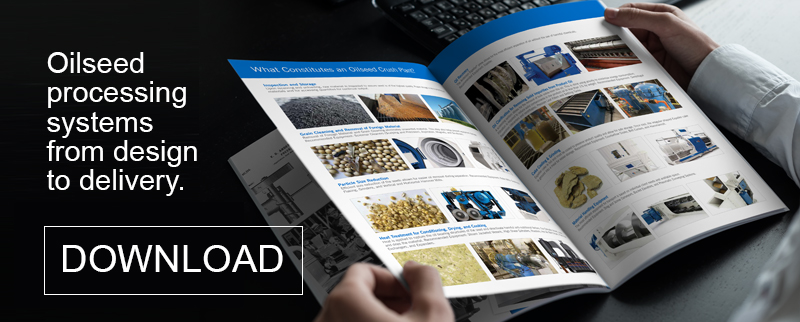
From the grocery aisles to the cosmetic counter, about half of all packaged goods on retail shelves today contain a byproduct from the oil palm. This tropical tree supplies not one but two of the world’s most versatile vegetable oils used to make ice cream creamy, crackers crispy, soaps bubbly, and much more. Although palm oil and palm kernel oil originate from the same palm tree, these two types of oil have unique properties and benefits that make each oil valuable in different industries.
Both types of oil are growing in popularity worldwide, driven by the crop’s high-yield potential, low-cost production, and wide range of product applications. By understanding the differences between palm oil and palm kernel oil, processors can tap into the growth potential of this versatile crop and learn more efficient ways to meet increasing global demand.
Palm oil from the fruit
Palm oil comes from the fleshy pulp of the oil palm fruit, which grows in clusters called fresh fruit bunches (FFB). Each bunch contains up to 3,000 fruits and weighs between 20 and 50 pounds. Certain varieties of oil palm can produce more than 20 tonnes of FFB per hectare annually, yielding approximately 5 tonnes of palm oil.
Oil palm fruits are often processed using traditional, manual methods in remote tropical villages. Plantation workers harvest FFB by hand and manually remove the individual fruits from the bunch. Then, they cook the fruit in hot water to soften the pulp before pounding it by hand or trampling it by foot to squeeze out the oil.
As the industry has evolved, processing technologies have advanced with increased mechanization. In larger-scale palm oil mills, processors cook the fruit in steam-heated vessels and mash it with rotary beaters to rupture the oil-bearing cells. Then, the mash is crushed in a screw press to separate the palm oil from the solid material, like other methods of oilseed processing.
Crude palm oil takes on a dark reddish-orange color due to high levels of beta-carotene (also found in carrots). A rich source of tocotrienols like vitamin E, this red palm oil boasts a range of nutritional benefits and a sharp flavor that makes it a staple in many African cuisines.
Most of the palm oil used in food manufacturing has been refined to remove these pigments and flavors, resulting in a bland, neutral oil. Refined palm oil appears as an ingredient in many confections, shortenings, and dairy substitutes — giving chocolate its shine, keeping ice cream from melting, and stopping peanut butter from separating.
With a balanced ratio of saturated and unsaturated fatty acids, palm oil is prized as a relatively healthy edible oil free from trans fats and cholesterol. As food manufacturers look for low-cost replacements for trans fats, palm oil is well-positioned as a smart edible alternative.
Also read: The Challenge of Small-Scale Oilseed Processing: Paying Off Your Investment
Pressing palm kernel oil
The solid residue that remains after pressing palm oil from the fruit includes palm nuts as a byproduct. Inside these nuts are oil-rich seed kernels that can be separately pressed to extract a different kind of oil that’s semi-solid at room temperature, similar to coconut oil. These kernels are typically processed at different facilities than the palm fruits, although some independent operations handle the entire product stream.
On small plantations, workers separate the nuts from the fiber by hand, then the nuts are dried and sold to palm kernel oil mills. More extensive operations use a machine called a depericarper to separate the nuts from the fiber more efficiently. Mechanical nut crackers crunch the shells to release the kernels, but separating these materials requires a clay bath — the density of which causes the shells to sink while the kernels float to the top. The kernels are dried to a moisture level of 7% before pressing.
Around the world, methods of pressing palm kernel oil vary greatly depending on the mechanical sophistication of each plant. Some mills press the kernels without pre-treatment, accelerating wear and tear on the equipment. Other plants partially pre-treat the kernels by grinding the seed material into flakes. More advanced operations completely pre-treat the material first by:
- Flaking the kernels in a grinder to increase the surface area of the material to be pressed.
- Cooking the flaked palm kernel in steam-conditioned vessels to solidify the proteins and release the oil.
- Drying the cooked kernel flakes to 3% moisture for more efficient pressing.
Whether the kernels are direct-pressed, partially pre-treated, or thoroughly flaked, cooked, and dried, the material enters a screw press that squeezes out the palm kernel oil. The high fat content of these seeds requires a second pressing to obtain maximum oil yields, reducing the residual oils to less than 7%.
Double pressing requires twice as much equipment, or at least double the energy consumption, to run material through the same machines twice. The Anderson Super Duo™ Series Expeller® streamlines this process by crushing the kernels twice in a single pass. The unique dual-press design reduces residual oils to 6-8%, shrinking the mill’s equipment footprint and energy consumption with a more efficient machine.
Learn more about capitalizing on specialty oils and fats with the Anderson Super Duo.
Palm kernel oil applications
Unlike its perfectly balanced heart-healthy counterpart, palm kernel oil from the nut contains much higher levels of saturated fat than palm oil from the fruit. This fatty acid composition makes palm kernel oil semi-solid at room temperature, making it helpful in formulating soaps, detergents, cosmetics, lotions, and other personal care products.
Although it doesn’t boast the same nutritional benefits as palm fruit oil, palm kernel oil is also often used for cooking and frying processed foods, thanks to its low cost and stability at high temperatures. Palm kernel oil is a common ingredient in cocoa butter, coffee creamer, cheese analogs, margarines, and spreads.
Due to palm kernel oil’s versatile industry applications, it commands a slightly higher market price than palm oil. However, the demand for both continues to grow. Palm oil’s global production volume of 76 million tonnes, and palm kernel’s production volume of 8 million metric tons, are both set to expand to meet rising demands. The $62.5 billion palm kernel oil market is expected to top $85 billion within the next five years, while palm oil production is projected to reach 240 million metric tons by 2050.
To meet this growing demand for both types of palm oil, processors are looking for more efficient, scalable extraction methods to keep pace with expansion. By leveraging the Super Duo’s dual-press design to squeeze as much profit from this tropical nut as possible, processors can position themselves for success in a quickly growing market.
To learn more about pressing palm kernel oil more efficiently, contact a representative today.
